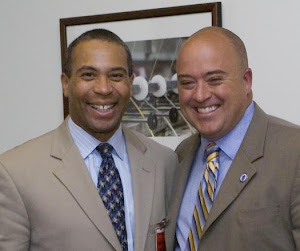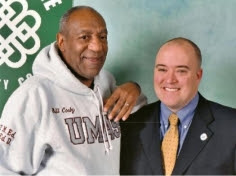"Lifelong illnesses feared for children in Katrina trailers: FEMA and CDC criticized on delay in moving tenants"
By John Moreno Gonzales, Associated Press, May 28, 2008
BAY ST. LOUIS, MISS. - The anguish of Hurricane Katrina should have ended for Gina Bouffanie and her daughter when they left their FEMA trailer. But with each hospital visit and each labored breath her child takes, the young mother fears it has just begun.
"It's just the sickness. I can't get rid of it. It just keeps coming back," said Bouffanie, 27, who was pregnant with her now 15-month-old daughter, Lexi, while living in the trailer. "I'm just like, Oh God, I wish like this would stop.' If I had known it would get her sick, I wouldn't have stayed in the trailer for so long."
The girl, diagnosed with severe asthma, must inhale medicine from a breathing device.
Doctors cannot conclusively link her asthma to the trailer. But they fear she is among tens of thousands of youngsters who may face lifelong health problems because the temporary housing supplied by the Federal Emergency Management Agency contained formaldehyde fumes up to five times the safe level.
The chemical, used in interior glue, was detected in many of the 143,000 trailers sent to the Gulf Coast in 2006. But a push to get residents out of them, spearheaded by FEMA and the Centers for Disease Control and Prevention, did not begin until this past February.
Members of Congress and CDC insiders say the agencies' delay in recognizing the danger is being compounded by studies that will be virtually useless and the lack of a plan to treat children as they grow.
"It's tragic that when people most need the protection, they are actually going from one disaster to a health disaster that might be considered worse," said Christopher De Rosa, assistant director for toxicology and risk assessment at the federal Agency for Toxic Substances and Disease Registry, an arm of the CDC. "Given the longer-term implications of exposure that went on for a significant period of time, people should be followed through time for possible effects."
Formaldehyde is classified as a probable carcinogen, or cancer-causing substance, by the Environmental Protection Agency. There is no way to measure formaldehyde in the bloodstream. Respiratory problems are an early sign of exposure.
Young children are at particular risk. Thousands who lived in trailers will be in the prime of life in the 10 to 15 years doctors believe it takes cancer to develop.
FEMA and CDC reports so far have drawn criticism.
A CDC study released May 8 examined records of 144 Mississippi children, some of whom lived in trailers and others who did not. But the study was confined to children who had at least one doctor's visit for respiratory illness before Katrina.
It was largely inconclusive, finding children who went to doctors before the August 2005 storm were still visiting them two years after.
A bigger, five-year CDC study will include up to 5,000 children in Louisiana, Mississippi, Alabama, and Texas, and CDC officials said it should begin next year. But members of Congress point to the decade or longer it could take for cancer to develop and say a five-year look is inadequate.
"Monitoring the health of a few thousand children over the course of a few years is a step in the right direction, but we need commitment," said Representative Bennie Thompson, Democrat of Mississippi.
Thompson has introduced legislation to force FEMA and CDC to provide health exams for trailer residents who believe formaldehyde made them ill.
The bill is similar to $108 million legislation for workers who labored at the World Trade Center site.
-
www.boston.com/news/nation/articles/2008/05/28/lifelong_illnesses_feared_for_children_in_katrina_trailers/
-
----------
-

-
Tens of thousands of people displaced by Hurricanes Katrina and Rita along the Gulf Coast in 2005 are still living in trailers provided by the Federal Emergency Management Agency. (DANNY JOHNSTON/ASSOCIATED PRESS/ FILE 2007)
-
"Report details trailer woes: Wood products emitting fumes in FEMA units"
By Maggie Fox, Reuters, July 3, 2008
WASHINGTON - Pressed-wood products such as particle board are the main source of irritating formaldehyde fumes in trailers being used to house disaster victims, according to a US government report released yesterday.
Such temporary housing should be designed with better ventilation, the report from the US Centers for Disease Control and Prevention suggests, and current health and safety standards may not be enough to protect people.
"Even though construction materials meet standards . . . you have to be a little bit careful about how you use those construction materials," said Glen Nowak, CDC spokesman. "You could end up fostering high levels of formaldehyde."
Tens of thousands of people displaced by Hurricanes Katrina and Rita along the Gulf Coast in 2005 are still living in such trailers, and the Federal Emergency Management Agency is sending hundreds more to people displaced by Midwestern flooding.
James Kaplan, FEMA spokesman, said the mobile homes being sent to people displaced by flooding had been tested for formaldehyde levels.
The CDC contracted with Lawrence Berkeley National Laboratory in California to cut open several trailers and measure concentrations of formaldehyde and other irritating chemicals, known as volatile organic compounds.
"We refer to it internally as the chain saw study," Nowak said. "We went beyond formaldehyde and looked at levels of other volatile organic compounds. Were there certain parts of the trailer - walls, ceiling, floors, cabinets - that made a greater contribution to the levels of formaldehyde in these trailers?"
Not surprisingly, the scientists found that processed-wood products such as particleboard and plywood were the main source of formaldehyde. They did not find other chemicals at significant levels.
Formaldehyde, used to manufacture many building materials, can irritate the skin, eyes, nose, and throat. High exposure levels may cause cancer.
The Department of Housing and Urban Development identified particleboard and plywood as two of the largest sources of formaldehyde emissions in 1985 and set standards for manufactured homes to limit them.
Nowak said all the relevant agencies would meet to discuss what to do.
"It has implications for FEMA as FEMA looks at emergency housing," Nowak said. "One of the factors they need to consider is indoor air quality and the construction materials used in the ventilation systems."
An earlier CDC study showed the average level of formaldehyde in trailers and mobile homes was about 77 parts per billion, a level high enough to increase the odds of cancer and respiratory diseases.
The Manufactured Housing Institute said gypsum board was now used in 95 percent of walls and ceilings in manufactured housing.
Michael McGeehin, director of CDC's Division of Environmental Health Hazards, said the findings applied only to trailers distributed by FEMA in the Gulf Coast region.
"However, taken together, the two studies indicate that manufacturers of travel trailers and the government agencies that influence their design should consider using construction materials that emit lower levels of formaldehyde as well as designs that increase outside air ventilation," McGeehin said in a statement.
The House Oversight and Government Reform Committee plans a hearing on the issue next Wednesday.
-
www.boston.com/news/nation/washington/articles/2008/07/03/report_details_trailer_woes/
-
----------
"FEMA seeks immunity from suits over trailers"
By Michael Kunzelman, Associated Press, July 24, 2008
NEW ORLEANS - The Federal Emergency Management Agency asked a federal judge yesterday for immunity from lawsuits over potentially dangerous fumes in government-issued trailers that have housed tens of thousands of Gulf Coast hurricane victims.
Lawyers for victims of hurricanes Katrina and Rita accuse FEMA of negligence for sheltering them in trailers with elevated levels of formaldehyde, a preservative used in construction materials that can cause health problems.
But a government lawyer told US District Judge Kurt Engelhardt that the FEMA's decisions in responding to a disaster, including its use of travel trailers after Katrina, are legally protected from "judicial second-guessing."
"It is what the legislative branch is supposed to second guess, and they are doing that," Department of Justice attorney Henry Miller said, referring to a series of congressional hearings on formaldehyde concerns.
Plaintiffs lawyer Gerald Meunier said FEMA can be held liable for providing hurricane victims with trailers that didn't meet federal safety standards and weren't designed to be long-term housing.
"Some of these people are still living in these trailers almost three years later," Meunier said.
Engelhardt took FEMA's request for immunity under advisement.
The judge is presiding over several consolidated cases filed against the federal government and the companies that supplied FEMA with tens of thousands of trailers after Katrina made landfall on Aug. 29, 2005, and Rita struck about a month later.
The lawsuits accuse trailer makers of providing FEMA with shoddily built units in a rush to meet the agency's demand for emergency housing. Plaintiffs also say FEMA ignored concerns about formaldehyde levels in trailers for months after Katrina.
----------
"FEMA fuel storage threatening water: Underground tanks require inspection"
The Associated Press, Wednesday, August 13, 2008
WASHINGTON (AP) — The government owns hundreds of underground fuel tanks — many designed for emergencies back in the Cold War — that need to be inspected for leaks of hazardous substances that could be making local water undrinkable.
The Federal Emergency Management Agency has known since at least the 1990s that tanks under its supervision around the country could be leaking fuel into soil and groundwater, according to Associated Press interviews and research.
The agency knows of at least 150 underground tanks that need to be inspected for leaks, according to spokeswoman Debbie Wing. FEMA also is trying to determine by September whether an additional 124 tanks are underground or above ground and whether they are leaking.
There has been no documentation of reported leaks or harm to communities from the FEMA tanks, Wing said, although former agency officials and congressional testimony suggest that the federal tanks have long been seen as a problem.
Many of these tanks were built to store 5,000 gallons of diesel fuel and placed around the country at the height of the Cold War back in the 1960s to fuel electric generators that could sustain emergency broadcasts by radio stations in case of a nuclear attack or other catastrophe. Made of steel, the tanks inevitably rust over time and allow fuel to escape.
Steel tanks left in the ground for decades rot like Swiss cheese, said Pat Coyne, director of business development for Environmental Data Resources Inc. Coyne said a joke in the industry is: "What percentage of steel tanks leak? 100 percent!"
In the late 1980s and early 1990s the government insisted on better-made tanks. The underground tanks of today must have safety measures including leak detection and an extra shell made with material resistant to gasoline, diesel and ethanol, Coyne said.
The FEMA tanks are part of a larger problem. More than 500,000 leaking storage tanks — most of which are filled with fuel and oil — are buried across the country, according to Environmental Data Resources, based in Milford, Conn. That's about half of all the underground tanks in the country, the consulting company says. Those tanks are owned privately or by local, state and federal agencies.
Because they're underground, leaking tanks can go undetected for years. If diesel leaks into drinking water, affected people could be at a higher risk of cancer, kidney damage and nervous system disorders, said Rochelle Cardinale, one of the lead coordinators for underground tank cleanup in Iowa. A gallon of fuel can contaminate 1 million gallons of water.
FEMA says the hundreds of federal tanks have not always been its responsibility. The Federal Communications Commission also has had oversight, although FCC spokesman Clyde Ensslin said the commission believed FEMA was responsible for monitoring and maintaining the tanks. FEMA said it spent $8 million in the 1990s removing and repairing some of them.
FEMA now acknowledges that it is the agency responsible for all of the tanks in question.
But Senate testimony from 1992 suggests FEMA has long tried to avoid having to deal with the tanks.
"For years FEMA resisted acknowledging the problem or seeking funds for remediation," former FEMA union president Leo Bosner said in 1992 before a Senate Appropriations subcommittee.
He said then there were more than 2,000 underground oil storage tanks that FEMA had paid for or acquired over the years. But FEMA came out with a legal opinion that year concluding that it wasn't responsible for the tanks.
Congress eventually decided it didn't matter which agency owned the tanks — FEMA would fund tank inspection, removal and replacement, said Bill Cumming, who at the time ran FEMA's ethics program.
----------
"FEMA: Government wasted cash on contracts"
The Associated Press, Thursday, September 11, 2008
WASHINGTON (AP) — The government wasted millions of dollars on four no-bid contracts it handed out for Hurricane Katrina work, including paying $20 million for a camp for evacuees that was never inspected and proved to be unusable, investigators say.
A report by the Homeland Security Department's office of inspector general, obtained yesterday by The Associated Press, is the latest to detail mismanagement in the multibillion-dollar Katrina hurricane recovery effort, which investigators have said wasted at least $1 billion.
The review examined temporary housing contracts awarded without competition to Shaw Group Inc., Bechtel Group Inc., CH2M Hill Companies Ltd. and Fluor Corp. in the days immediately before and after the August 2005 storm that smashed into the U.S. Gulf Coast.
It found that FEMA wasted at least $45.9 million on the four contracts, which together were initially worth $400 million. FEMA subsequently raised the total amounts for the four contracts twice, both times without competition, to $2 billion and then $3 billion.
FEMA did not always properly review the invoices submitted by the four companies, exposing taxpayers to significant waste and fraud, investigators wrote. In many cases, the agency also issued open-ended contract instructions for months without clear guidelines on what work needed to be done and the appropriate charges.
"We question how FEMA determined that the amounts invoiced were allowable and reasonable," the IG report states, warning that its review was limited in scope, so additional waste and fraud might yet to be found.
Responding, FEMA said it generally agreed with the IG report and would further investigate the $45.9 million in questioned costs and recoup the money as necessary. FEMA said it has taken several steps to improve its disaster response since the 2005 storm, such as requiring a standard invoice form and better tracking inventory.
The agency also noted that the four no-bid contracts were rebid on a competitive basis in August 2006. The contracts were subsequently awarded to six companies, including Shaw, Bechtel, CH2M Hill and Fluor, which received the original no-bid agreements.
"As FEMA works toward refining its programs, the office of inspector general's independent analysis of program performance greatly benefits our ability to continuously improve our activities," wrote Marko Bourne, director of FEMA's office of policy and program analysis.
According to the report, FEMA tasked Fluor with arranging a "base camp" to house up to 300,000 Katrina evacuees as the hurricane neared the Gulf Coast. FEMA's request required Fluor to conduct a site inspection before ordering tents, but Fluor did not do so and FEMA subsequently found the site to be unusable.
Still, Fluor charged FEMA $20 million for the tents, which FEMA paid. The IG said that figure included $8.7 million to cancel the lease and for other questionable expenses despite Fluor's failure to perform its obligations. The report questioned FEMA's decision to pay the $8.7 million without further review.
Other findings:
. Fluor did not always notify FEMA when it conducted emergency maintenance as required, such as replacing air-conditioning units, refrigerators and propane tanks. Fluor said it received approval from FEMA to perform the emergency work without notice, but no evidence exists that FEMA authorized it.
. FEMA lacked a real-time inventory system to ensure that property attained and maintained by the four contractors, such as trailers, was properly accounted for.
----------
"Ex-FEMA worker gets 5 years in fraud"
December 6, 2008
WASHINGTON - A former FEMA worker who stole the identities of disaster victims to go on shopping sprees, which a federal judge called "low down," was sentenced yesterday to more than five years in federal prison.
Robert G. Davis, 44, of the District of Columbia, got 64 months in prison from US District Judge Reggie Walton, and was ordered to pay $48,765.80 in restitution.
He pleaded guilty earlier this year to one count of wire fraud and one count of aggravated identity theft.
"I made a mistake by doing this. I'm extremely sorry," David said.
But an angry Walton said Davis deserved the sentence because he preyed on people who were already devastated by natural disasters.
"Rather than trying to help these people, you hurt them even more," said Walton, describing it as akin to kicking a homeless person. "That's low down. It really is."
Davis stole the identities of over 200 people while working at several mortgage companies and with natural disaster victims while at the Federal Emergency Management Agency from December 2003 to November 2007. About 30 of those people had given their information to FEMA as part of their applications for disaster relief.
ASSOCIATED PRESS
----------
"Bush comments on Katrina sound sour in New Orleans"
Associated Press, Tuesday, January 13, 2009
NEW ORLEANS (AP) - President George W. Bush can defend the federal government's response to Hurricane Katrina. But to Gertrude LeBlanc, the view from her home in the city's Lower 9th Ward is all the evidence she needs to believe it was a failure.
A row of concrete foundations is all that's left where her neighbors' houses once stood.
"Bush didn't give a damn what we got," said the 73-year-old, who says she rebuilt her bright yellow house with the neat yard with help from a church group and the "little bit" in federal aid she got from the state-run program meant to help hurricane-affected homeowners, Road Home.
"To me, black folks weren't handled right, but we can't worry about it. We have to do the best we can."
When Bush leaves office next week, New Orleans will still show the scars of Hurricane Katrina, which slammed ashore on Aug. 29, 2005. LeBlanc's neighborhood is still largely uninhabited, with weeds tall around some decrepit houses and roads cracked and warped. In some neighborhoods, apartment buildings and businesses are empty. Some houses still bear the haunting markings left by search teams in the frantic aftermath of the storm.
Bush, in some of his last comments before leaving office, said Monday at a news conference that he stood behind the federal government's response to Katrina, even though he admitted once again that some things could have been done differently and acknowledged there's still more work to do. Those words stung for people still living in the aftermath of the storm, still waiting for neighbors to come home.
"More people need to have their own home there," Bush said. "But the systems are in place to continue the reconstruction in New Orleans. You know, people said, 'Well, the federal response was slow.' Don't tell me the federal response was slow when there was 30,000 people pulled off roofs right after the storm passed."
The comment drew an at-times exasperated response from residents like LeBlanc and government leaders, some of whom believe federal bureaucracy is still choking recovery efforts.
"Clearly there were mistakes made at every level of government, and I and other Louisiana leaders have accepted responsibility for our own," Sen. Mary Landrieu said. "But no state is equipped to respond to a catastrophe of this magnitude, and for this reason, federal law specifically tasks the federal government to step up. It did not, and the president's failure to account for that responsibility more than three years later is terribly disappointing."
Former Gov. Kathleen Blanco, the Democrat in office when the storm hit, said state and local officials and volunteers played a major role in the rescue effort.
"President Bush is totally wrong about the federal response," said Blanco, who didn't seek re-election after her image was battered following the state's response to both Hurricanes Katrina and Rita. "It was absolutely too slow in those early, critical days."
Residents here have levied criticism at every level of government since the storm, not just the White House. After levees failed during Katrina, an estimated 80 percent of New Orleans was under water. The surrounding area and parts of the Mississippi Gulf Coast were essentially wiped out. A massive military presence didn't arrive until days after the storm, and the storm is blamed in the death of more than 1,600 people across Louisiana and Mississippi.
A tug-of-war between federal, state and local government has persisted in the years since. State and local officials have complained about red tape tied to aid programs, and Republican Gov. Bobby Jindal said Monday that a backlog of infrastructure project worksheets under appeal or in dispute with the Federal Emergency Management Agency "continues to hinder the recovery efforts of our communities that cannot finish rebuilding their schools and police and fire stations."
Residents who've returned have dealt with red tape, too, and in New Orleans, there are also issues of crime and a still-rebuilding health care system.
Since the 2005 hurricanes, the Bush administration said the federal government has set aside more than $126 billion for rebuilding and recovery. And progress is being made, including in rebuilding the levee system that protects New Orleans.
The federal government "has been a good partner in the Hurricane Katrina recovery effort, and we appreciate the efforts of both the Bush administration and the Congress in the wake of the worst natural disaster in America's history," Mississippi Gov. Haley Barbour, a Republican, said.
Bush's hurricane recovery chief, retired Maj. Gen. Doug O'Dell, said last month he believed the federal government had provided ample resources to Louisiana and Mississippi to do the needed work, and the signs of those resources are showing now.
But some still aren't convinced. "It's getting to the point it's almost like a forgotten cause," said the Rev. Terrence Ranson, who believes Bush hasn't lived up to the promises of a rebuilding he made during a speech from empty Jackson Square weeks after Katrina.
Melanie Ehrlich, a resident and frequent critic of the state-run Road Home program, said that residents, not government at any level, have rebuilt the city.
"They've done this in spite of a response by the federal government that has been too slow and much more concerned about bureaucratic rules that did not fit with this historic disaster," she said.
The Katrina response "is still a national disgrace, and New Orleans, in many places, still looks like a war-torn city."
----------
-

-
In this Aug. 19, 2008 file photo, Florida emergency management Craig Fugate, left, accompanied by Florida Gov. Charlie Crist, briefs reporters in Tallahassee, Fla. Fugate is President Barack Obama's choice to lead the Federal Emergency Management Agency (FEMA). (AP Photo/Phil Coale, File).
-
"Obama picks Florida's Fugate to head FEMA"
By EILEEN SULLIVAN and BRENT KALLESTAD, Associated Press Writers, news.yahoo.com, March 4, 2009
WASHINGTON – President Barack Obama on Wednesday (March 4, 2009) tapped Florida emergency manager Craig Fugate to head the Federal Emergency Management Agency, turning to a Republican appointee who has steered the Southern state through numerous hurricanes since 2001.
In a statement issued by the White House, Obama said he plans to nominate Fugate who will help the administration "improve our preparedness, response and recovery efforts."
Obama said Fugate will travel with Homeland Security Secretary Janet Napolitano to the Gulf Coast on Thursday to meet with local officials still struggling to recover from 2005 hurricanes.
Fugate, who faces Senate confirmation once he is nominated, has been director of Florida's Division of Emergency Management since 2001, chosen by former Gov. Jeb Bush. He was retained by current Gov. Charlie Crist. Both governors are Republicans.
Before that, Fugate was the agency's assistant director for more than four years.
Fugate has been praised for helping guide Florida through several devastating hurricanes in the past decade. He was criticized in 2005 for not distributing enough ice, water and other supplies immediately after Hurricane Wilma. Fugate had warned residents before the storm that they should have enough supplies for three days after it passed, but many did not and that overstressed the system.
Napolitano called Fugate one of the most experienced emergency managers in the country.
"The work he's accomplished in Florida serves as a model for other states," Napolitano said in a statement. "He will be a tremendous asset to FEMA and it's employees."
After Hurricane Katrina, Fugate said there was too much focus on blaming the federal government for the botched response. He said in a 2006 interview with The Associated Press that it was the state's responsibility to prepare for such disasters, and the state should only turn to the federal government for help when the disaster is larger than the state can handle on its own.
Fugate's department was held up as a national model after the Sept. 11, 2001 terrorist attacks. He said then that the state had been preparing extensively for the threat of terrorism since the 1995 Oklahoma City bombing and had done exercises for several possibilities, including cruise missile attacks.
Obama's decision to name Fugate drew praise from Florida lawmakers and the International Association of Emergency Managers, which represents local emergency managers around the country.
Since Hurricane Katrina, when FEMA arrived both late and unprepared, the agency has been under intense public scrutiny and Congress passed a law requiring the head of FEMA to have emergency management experience.
During Katrina, the agency couldn't track supplies or get those it had to the right place. FEMA was unable to provide then Homeland Security Secretary Michael Chertoff and other top federal officials with accurate or timely information from the area hit by Katrina, particularly about inhumane conditions confronting victims who sought shelter at New Orleans' Superdome and convention center.
FEMA's past administrator, R. David Paulison, who came on shortly after Katrina, said Fugate is the right choice for the job. "There are few people around the world that have the type of disaster experience that Craig Fugate has," Paulison said.
Paulison said Fugate's biggest immediate challenges are how to house catastrophic disaster victims who are displaced from their homes and how to make the long-term recovery process more efficient.
Thousands of victims of Hurricanes Katrina and Rita are still living in temporary housing 3 1/2 years after the storms. Katrina was blamed for more than 1,600 deaths and $41 billion in property damage.
Paulison predicted that Fugate will be shocked when confronted by the federal bureaucracy when he takes over FEMA.
"The bureaucracy up there is tremendous," Paulison said of the federal government. "It can be very frustrating to get things done."
Fugate has been critical of the Homeland Security Department over the years. In a 2006 letter to a high-ranking homeland official, Fugate slammed the department's review of hurricane preparedness exercises for Florida's region. "The products are wonderful in terms of color enhancement, texture, physical craftmanship, etc.," Fugate wrote, sarcastically. But, he said, the reviews did not reflect the work Florida had done to respond to Hurricane Katrina.
-
Associated Press Writer Nancy Benac contributed to this report. Kallestad reported from Tallahassee, Fla.
-
----------
"FEMA nominee promises to improve agency response"
By EILEEN SULLIVAN, The Associated Press, Wednesday, April 22, 2009
WASHINGTON -- President Barack Obama's pick to head FEMA promised senators Wednesday that he would hold the disaster relief agency to a much higher standard than it displayed in the wake of the 2005 Gulf Coast hurricanes.
Craig Fugate and John Morton _ Obama's choice to lead Immigration and Customs Enforcement _ cruised through their Senate hearings Wednesday and appeared on a fast track for confirmation.
FEMA was widely criticized for its botched response to Katrina when the federal government showed up late and unprepared. Since then, the question has been: Is the FEMA response better than it was in 2005? The answer has been yes, though no disaster has been nearly as catastrophic as Katrina.
"Although the media may use the failures of Katrina and Rita as a standard of measurement for judging the effectiveness of government, this standard does not, in my opinion, meet our sworn commitment to the American people," Fugate said in written testimony.
Fugate previously served as head of emergency management in Florida where he worked for two Republican governors. In that position, he oversaw a staff of 138. If confirmed to head FEMA, he would oversee more than 3,500 employees.
Fugate has been praised for helping guide Florida through several devastating hurricanes in the past decade. He was criticized in 2005 for not distributing enough ice, water and other supplies immediately after Hurricane Wilma. Fugate had warned residents before the storm that they should have enough supplies for three days after it passed, but many did not, and that overstressed the system.
During questioning by senators, Morton said one of his top priorities would be immigrant detention policies and improving how they are treated while in U.S. custody.
"The power of detention is a very important power," Morton said. But he said the agency needs to "take a hard look" at whether the people who are being detained have committed crimes or pose a flight risk.
Morton is currently a senior official at the Justice Department. Throughout his career he has worked on immigration enforcement cases, both as a trial attorney at the now defunct Immigration and Naturalization Service and as an assistant U.S. attorney.
Echoing what Homeland Security Secretary Janet Napolitano has been saying, Morton said going after the employers who hire illegal workers would be the agency's focus under his leadership. He said he is concerned that during the Bush administration there was "an imbalance" between the number of employers prosecuted and the number of workers prosecuted. In 2008, the agency brought criminal charges against 135 employers and 968 workers.
Sen. Joseph Lieberman, chairman of the Homeland Security and Governmental Affairs committee, said he hoped the nominees would be confirmed as early as next week. Lieberman is a Connecticut independent who organized with Senate Democrats.
----------
"FEMA unveils its new disaster trailer"
By Associated Press, May 15, 2009
EMMITSBURG, Md. - A fleet of newly designed mobile homes was rolled out here yesterday by federal officials to replace the much-criticized travel trailers used after Hurricane Katrina in 2005.
The new mobile homes - six models were designed - were built as part of a $400 million federal program overseen by the Federal Emergency Management Agency.
The new models were being toured by FEMA officials. The trailers have been tested and meet FEMA standards for safe formaldehyde levels.
After Katrina, 1 million people lost their homes in Louisiana and Mississippi. FEMA sent thousands of mobile homes into the region only to learn later of high levels of formaldehyde, a preservative used in building materials that can lead to breathing problems and is also believed to cause cancer.
Residents of FEMA-issued trailers reported frequent headaches, nosebleeds, and other ailments.
There is no industry standard for the amount of formaldehyde allowed in travel trailers. The government sets standards for indoor air quality for materials used to build mobile homes, but not for travel trailers.
Government tests in 2007 found an average of 77 parts formaldehyde per billion parts of air in FEMA trailers issued after the 2005 hurricanes. FEMA's standard for the new trailers is 16 parts formaldehyde or less per billion parts of air.
By FEMA's count, 2,570 trailers and mobile homes are still being used in Louisiana and 1,500 in Mississippi to house victimes of Hurricanes Katrina and Rita.
----------
-

-
A recent GAO report concluded that FEMA has not clarified multiple agencies' roles in large-scale disasters. (David J. Phillip -- Associated Press)
-
"GAO Cites FEMA Preparedness Gaps: Agency Making Progress, Report Says"
By Steve Vogel, Washington Post Staff Writer, Monday, June 8, 2009
Almost four years after Hurricane Katrina devastated the Gulf Coast, the Federal Emergency Management Agency has failed to clarify the responsibilities of different agencies that would respond to such disasters, according to a recent report by the Government Accountability Office.
One result is that FEMA lacks assurances that the agencies have improved preparedness since the deadly hurricane in August 2005 exposed numerous flaws in the nation's readiness for large-scale catastrophes.
Among the gaps revealed by the disaster were confusion about the roles of federal, state and local officials; limitations in the help provided to those with special needs, such as nursing home residents; and problems providing food, water and other goods to victims.
Legislation passed by Congress in October 2006 in the aftermath of Katrina charged FEMA with responsibility for developing and implementing a national preparedness system that would ensure the mistakes are not repeated.
The GAO report, which was released last month, finds that while FEMA has made progress in developing such a system, it lacks a plan for assessing improvements.
The Department of Homeland Security, which oversees FEMA, said in its response to the GAO report that it generally concurs with the recommendations and is already taking steps to improve.
But the department said that because FEMA lacks authority over other federal agencies and departments or state and local governments, it is unfair to expect the agency to compel compliance with the national preparedness system.
"There is . . . a concern that in a number of areas the report suggests that DHS/FEMA should hold other federal agencies and departments or state, local or tribal governments, accountable for compliance with program requirements," Jerald E. Levine, director of the DHS office responsible for working with GAO, wrote in the response.
The GAO conceded that FEMA lacks authority to compel other agencies to act but said FEMA should nonetheless "instill a shared sense of responsibility and accountability on the part of all stakeholders for the successful development and implementation of the national preparedness system."
The report noted that although the post-Katrina legislation requires FEMA to track corrective actions taken in response to training exercises, it has not done so effectively.
"Without such information, federal agencies cannot be held accountable for implementing corrective actions that aim to improve preparedness," the report said, adding that the problem is not new. A report from the White House in February 2006 said that DHS should ensure that all federal and state entities carry out remedial actions in a timely manner, according to the GAO.
FEMA has not coordinated with other federal departments and agencies to define how improvements will be monitored, according to the report. Based in part on the GAO inquiry, FEMA officials agreed in February that a program management plan should be established, the report added.
----------
"Jury: FEMA Trailer Didn't Expose Family To Fumes"
By The Associated Press, September 24, 2009
A federal jury on Thursday rejected a New Orleans family's claims that the government-issued trailer they lived in after Hurricane Katrina was defective and exposed them to dangerous fumes.
A jury of five men and three women decided that a trailer made by Gulf Stream Coach Inc. and occupied by Alana Alexander and her 12-year-old son, Christopher Cooper, was not "unreasonably dangerous" in its construction.
The jury also concluded that Fluor Enterprises Inc., which had a contract to install FEMA trailers, wasn't negligent in doing so. The federal government wasn't a defendant in this first of several "bellwether" trials.
After eight days of testimony, the jury heard closing arguments in the case against Gulf Stream Coach and Fluor Enterprises.
Alexander and Christopher lived in a FEMA trailer for 19 months after Hurricane Katrina damaged their home in August 2005.
Alexander's lawyers claimed elevated levels of formaldehyde in the family's trailer aggravated Cooper's asthma and increased his risk of getting cancer. Formaldehyde, a chemical commonly found in construction materials, can cause breathing problems and has been classified as a carcinogen.
Plaintiffs' attorneys accused Gulf Stream and other trailer makers of using shoddy materials and methods in a rush to meet the Federal Emergency Management Agency's unprecedented demand for temporary shelters after hurricanes Katrina and Rita.
Gulf Stream denied its trailer jeopardized the health of Alexander and her family. Andrew Weinstock, a lawyer for the Nappanee, Ind.-based company, said FEMA had purchased thousands of trailers from Gulf Stream since 1992 without receiving any formaldehyde complaints until 2006.
----------
-

-
"FEMA's sale of Katrina trailers sparks criticism"
By Spencer S. Hsu, The Washington Post (Online) A01; March 13, 2010
In a giant auction, the federal government has agreed to sell for pennies on the dollar most of the 120,000 formaldehyde-tainted trailers it bought nearly five years ago for Hurricane Katrina victims. But the sale of the units, perhaps the most visible symbol of the government's bungled response to the hurricane, has triggered a new round of charges that it is endangering future buyers for years to come.
Consumer advocates and environmentalists are outraged that the government resold products it deemed unsafe to live in, saying warning stickers attached to the units will not keep people from misusing them.
Besides formaldehyde, units might be plagued by mold, mildew and propane gas leaks, FEMA acknowledged.
"Proceed with caution, extreme caution, if you are tempted to respond to what appears to be an attractive offer for a travel trailer or manufactured home," Arkansas Attorney General Dustin McDaniel wrote in a consumer alert. He and others cautioned that the FEMA units could be resold many times, including over the Internet, and that unscrupulous sellers could remove warning labels or withhold information about the dangers.
This year, for example, building inspectors in Missouri discovered damaged FEMA units sold as scrap in a Fenton, Mo., mobile home park. The units were billed as housing even though their paperwork specified they were not to be occupied.
"What if Toyota ordered a recall, then simply put a sticker on its vehicles saying they were unfit to drive before reselling them?" said Becky Gillette, a spokeswoman for the Sierra Club in Mississippi, which helped uncover the formaldehyde problem. "There's a double standard for the government."
The sale of the units will be completed by April 3, pending an antitrust review by the Justice Department, which has rarely reversed government auctions. In the meantime, the sale has drawn criticism from lawmakers upset about the loss of taxpayer dollars and from industry groups that say the fire sale is hurting their business.
FEMA officials defended the sale, noting that Congress has complained that the government has spent $220 million over three years to store vacant units. Wholesale buyers from the auction must sign contracts attesting that trailers will not be used, sold or advertised as housing, they said, and that trailers will carry a sticker saying, "Not to be used for housing."
Officials said that although formaldehyde could still be present in some units, they would be safe for occasional recreational use rather than round-the-clock living. They also say that, because most units are in such poor condition, people will not choose to live in them.
"I'm certainly hopeful we're approaching the end of the story for the Katrina units, which we have been maintaining in the hundreds and thousands of units, at the expense of taxpayers," said FEMA Associate Deputy Administrator David Garratt. "I'm hopeful we can reduce the inventory of units which we can no longer use, and actively maintain the units we can use in actual disasters."
But Marty Horine, a retired teacher from Clinton, Mo., cannot relate to FEMA's decision to resell flawed units. In summer 2007, days before congressional hearings publicized the formaldehyde problems, Horine paid about $6,000 for a 32-foot Gulfstream Cavalier FEMA trailer for her son to live in. Now she doesn't want him in it, but she worries that selling it "would be nothing but being mean to the next person."
"This is like history repeating itself," Horine said. "People are all going to buy them, move into them and then start getting sick."
FEMA's sale of nearly 93,000 towable trailers and more than 9,300 pad-mounted mobile homes drew high bids totaling $133 million, or about 7 cents on the dollar compared with what the government paid. The units were bundled into 11 huge lots and sold on Jan. 29 to bidders, whose identities have not been announced.
The decision to sell them in bulk, critics said, will glut a depressed market and keep them from being sold to individuals or donated to public agencies who could use them for storage or office space. It was also a bad business deal, some said, benefiting middlemen rather than the government.
"Taxpayers only lose in this scenario," said Rep. Mike Ross (D-Ark.), who on Friday called for congressional hearings into the auction.
The sale marks a fittingly contentious end to the federal government's ill-fated effort to house hurricane victims.
After Katrina displaced 770,000 Gulf Coast residents, the federal government embarked on what watchdog groups dubbed a "hurricane of waste." Lacking plans and contracting experts, FEMA spent $2.7 billion on 145,000 trailers and mobile homes. Many of the mobile homes, it turned out, could not be placed near the coast, under FEMA's own rules.
The agency rushed production of the trailers, with few safety specifications. Then, over nearly two years, FEMA officials suppressed internal warnings that there were health problems among 300,000 trailer occupants -- what lawmakers later called an "official policy of premeditated ignorance" -- before declaring that trailers should be abandoned in early 2008.
When they finally conducted tests, officials found formaldehyde levels in trailers five times greater than the average in most modern homes, and in some cases 40 times greater.
Formaldehyde, an industrial chemical widely used in wood, housing products and many other applications, including treatment for some clothing, can cause nasal cancer and worsens respiratory problems, studies show.
The mass sale came four weeks after a federal judge lifted a ban on the sale of some trailers, which are part of litigation brought by 40,000 former Katrina occupants against FEMA and the manufacturers.
FEMA officials "are shoveling the whole thing under the carpet to make it go away," said Scott E. Pepperman, executive director of the National Association of State Agencies for Surplus Property.
For the future, FEMA has set tight formaldehyde limits on new trailers it buys and overhauled disaster contracts to strengthen quality control.
But the U.S. Centers for Disease Control and Prevention still have not issued a contract for a long-promised study of the health effects on children who lived in trailers; no binding safety standards for formaldehyde in housing have been set; and FEMA is still fleshing out how it would manage housing in a future Katrina-scale catastrophe.
Aaron Mortrud, general manager of Greenlawn Homes of Columbus, Ohio, said the family-owned commercial real estate company was FEMA's single high bidder, offering $27 million for just more than 15,000 units stored in Hope, Ark. -- or $1,830 on average.
Formaldehyde in trailers is a "non-topic" among consumers, he said, adding that responsible sellers have all the required paperwork and disclosures. Buyers "don't ask about it any more than they do with cars or brand-new pairs of pants they wear," Mortrud said.
He said the low price reflects the poor quality of trailers. However, the bulk lots include more valuable manufactured homes, which have few contamination problems and are particularly sought by strapped families.
He has already lined up buyers for virtually all units -- retailers that he said could probably resell mobile homes for $15,000 to $21,000, or about a tenfold markup. That price is still cheap compared with new, $45,000 mobile home models that Mortrud sees.
The windfall will keep him from laying off 30 workers. "For us and probably for many, many other people," Mortrud said, "it's the difference between staying in business and not being in business."
----------
"Katrina victims still are without permanent homes"
Associated Press, February 16, 2011
NEW ORLEANS — Nearly 30,000 Hurricane Katrina victims were forced to live in a succession of five or more places after the storm hit, Census data released Monday showed, and about the same number said their permanent living situation was still in flux.
It was the latest Census data release to fill in the gaps about what has happened to the region since floodwalls and levees protecting the city broke, causing massive flooding and killing more than 1,600 people after the storm hit Aug. 29, 2005.
About four out of every five residents said they evacuated the city for at least a couple of weeks and had to relocate about two times. Also, 83 percent said they stayed in a house or apartment at least once during their displacement and about 31 percent said they stayed in a hotel, motel, or cruise ship.
The new data, based on surveys of 6,000 housing units in the second half of 2009, looked at the larger metropolitan area of New Orleans, made up of about 1.1 million people.
The new figures provide solid numbers to what has been a rich, but largely anecdotal, narrative of the Katrina displacement, said Allison Plyer, deputy director of the Greater New Orleans Community Data Center, a nonprofit analyzing the Katrina recovery.
“No one has been able to track the folks who have been displaced,’’ she said. “It’s been quite a mystery.’’
Earlier this month, Census data showed that New Orleans is a much smaller city than it was before Katrina and much of the loss in population was among blacks who have been unwilling or unable to return. In 2000, there were about 323,000 blacks in New Orleans compared with about 206,870 in 2010.
Another big hit was to the number of children under 18, which dropped by 56,193, or 43 percent, since 2000.
----------
6 years later, Katrina victims fight FEMA debts
cbsnews.com - December 28, 2011
(AP) NEW ORLEANS — When the Federal Emergency Management Agency mailed out 83,000 debt notices this year to victims of Hurricane Katrina and other 2005 storms, one of the letters showed up in David Bellinger's mailbox. Bellinger, who is blind, needed a friend to read it and break the news that FEMA wants him to pay back more than $3,200 in federal aid he received after Katrina.
"I nearly had a stroke," recalls the 63-year-old, who moved to Atlanta after the storm wrecked his New Orleans home. "I'm totally blind. I subsist entirely on a Social Security disability check. If I have to pay this money back, it would pretty much wipe out all the savings I have."
Many other Gulf Coast hurricane victims are in the same position, angry and frustrated at the prospect of repaying money they spent years ago as they tried to rebuild their lives.
FEMA is seeking to recover more than $385 million it says was improperly paid to victims of hurricanes Katrina, Rita and Wilma. The debts, which average about $4,622 per recipient, represent slightly less than 5 percent of the roughly $8 billion that FEMA distributed after the storms. At least some of the overpayments were due to FEMA employees' own mistakes, ranging from clerical errors to failing to interview applicants, according to congressional testimony.
But the agency says it is required by law to make an effort to recover improper payments, even if the recipient wasn't at fault. Last week, however, Congress approved legislation that would allow FEMA to waive many of the debts. President Barack Obama signed the measure — part of a $1 trillion spending package — into law last Friday.
FEMA spokeswoman Rachel Racusen said the agency is reviewing the law's provisions and developing a plan to implement them. It remains to be seen how many recipients of FEMA money could benefit from the change.
Sen. Mary Landrieu, a Louisiana Democrat who sponsored the provision, said disaster victims shouldn't be punished because FEMA was "dysfunctional."
"They have significantly improved the process," Landrieu said. "This is very unlikely to happen again."
Racusen said the agency has implemented "strong protections" to avoid making improper payments, reducing its error rate from about 14 percent after Katrina to less than 1 percent for more recent disasters.
"We have also worked to significantly improve the recoupment process so that it is more understandable and provides due process for both disaster survivors and taxpayers," she said in a statement.
FEMA's collection efforts aren't limited to the 2005 storms. The agency has mailed out more than 6,000 debt letters to survivors of other recent disasters, including floods.
Approximately 2,500 recipients, including 930 victims of the 2005 hurricanes, have appealed their debt notices. FEMA says about 30 percent of those appeals successfully erased at least some of the debt. Recipients also can ask for a waiver due to economic hardship.
"It is important for any individual who has received a recoupment notice to know that these letters are the start of a conversation with FEMA, not the end," Racusen said.
This isn't the first time Bellinger has tangled with FEMA over funds he received to pay for renting an apartment in Atlanta. He was a plaintiff in a class-action lawsuit over the agency's decision to end housing subsidies for storm victims and its efforts to recover alleged overpayments. FEMA later paid more than $2.6 million to settle the claims.
That case had also delayed the debt collection process that Bellinger and other storm victims are now facing. Before the settlement, a federal judge in New Orleans ordered FEMA to suspend the effort in 2007 while it drew up new guidelines for the recoupment process. FEMA reinstituted the process earlier this year.
"What a way to celebrate Christmas, knowing I've got another FEMA battle on my hands," Bellinger said last week.
After Bellinger moved to Atlanta, the U.S. Department of Housing and Urban Development covered some but not all of his rent. He says he relied on FEMA's aid to make up the difference. FEMA claims he received a duplication of benefits, but Bellinger said the agency is mistaken.
"The fault is theirs, not mine, and they have to suffer the consequences," he said. "I submitted everything they required. As far as I know, I did nothing wrong."
Lubertha Haskin, a Gulfport, Miss., resident who turned 80 on Dec. 27, received about $8,000 from FEMA to repair some of Katrina's damage to her home and replace belongings. In October, FEMA sent her a debt letter that said her insurer had covered the same costs, a claim Haskin denies.
Haskin said she hadn't heard from the agency in five years and never suspected she could have to pay back the money.
"I was knocked for a loop," she said. "I don't have that kind of money. I have a lot of doctor's bills and other bills to pay."
Law firms and legal aid groups have volunteered to help Haskin, Bellinger and many others challenge FEMA's recoupment efforts.
"It's really unfair that the government waited this long to come after this lady," said Haskin's lawyer, Beau Cole. "They didn't deliberately do it, but the effect is the same."
The New Orleans office of Southeast Louisiana Legal Services, which offers free legal aid, has fielded more than 100 calls since September from people who want to challenge their FEMA recoupment letter. Rowena Jones, a lawyer for the group, said she hasn't seen the appeals process yield any "actual results."
"Our clients just don't seem to be getting a fair opportunity to contest the notices and get a hearing on it," she said.
The provision signed into law last week allows FEMA to completely waive the debt for somebody who earns less than $90,000 a year if the money was mistakenly awarded due to an error by FEMA. A debt involving fraud cannot be waived. Racusen said FEMA is "committed to applying the law to the fullest extent possible."
U.S. Rep. Bennie Thompson, D-Miss., said the recoupment process is flawed. Many debt letters have been returned as "undeliverable," meaning some people moved and don't even know they owe money, he said.
"Most of these individuals went through a lot of trauma," Thompson said. "For our government to all of a sudden say, 'We made a mistake, you owe us money,' that's not how it should be done."
----------














































































































































.png)































































































































































































































































No comments:
Post a Comment